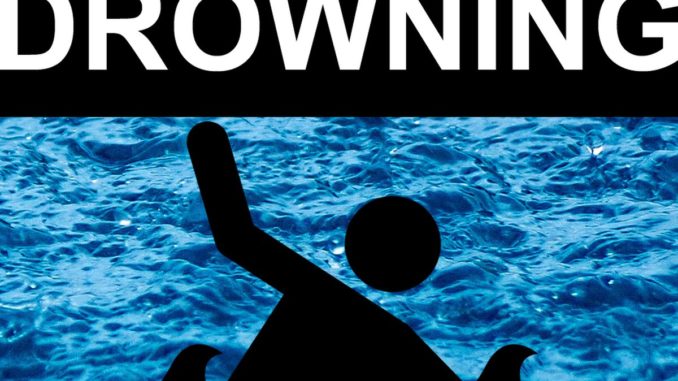
Table of Contents
What is Drowning?
- Drowning is the process of experiencing respiratory impairment from submersion or immersion in liquid.
- Drowning is a type of asphyxia death caused by fluid aspiration into the airways caused by submersion of the body in water or a fluid media.
- Drowning is the result of submersion/immersion in liquid causing breathing impairment; consequences include death, illness, and no morbidity.
- Submersion of the mouth and nose is sufficient; total submersion is not required.
Key Facts
- Drowning is the world’s third most common cause of unintentional injury death, accounting for 7% of all injury-related deaths.
- Every year, an estimated 236 000 people die from drowning around the world.
- Global estimates of the public health problem of drowning may be severely understated.
- While children are the most vulnerable to drowning, anyone can drown.
- Drowning that does not result in death can cause long-term health concerns and expensive hospital admissions.
Risk Factors of Drowning
Age
- Those aged 1–4 years have the highest drowning rates worldwide, followed by children aged 5–9.
- Drowning is the leading cause of death among children aged 5 to 14 years in the WHO Western Pacific Region.
Gender
- Males drown at a higher incidence than females, according to studies, due to more water exposure and riskier behavior such as swimming alone, drinking alcohol before swimming alone, and boating.
Access to water
- Individuals in low-income nations who work in commercial fishing or subsistence fishing and use tiny boats are more likely to drown.
- Children who live near open water sources like ditches, ponds, irrigation channels, or pools are particularly vulnerable.
Flooding
- Drowning is the leading cause of mortality in flood catastrophes, accounting for 75% of all deaths.
- Flooding increases the risk of drowning, especially in low- and middle-income nations where people live in flood-prone locations and flood warning, evacuation, and protection systems are weak or non-existent.
Travelling on water
- Migrants and asylum seekers frequently commute and travel on overcrowded, dangerous vessels that lack safety equipment or are operated by staff who are inexperienced in dealing with transportation issues or navigation.
Other risk factors
- Newborns left unsupervised or alone with another child near water
- Alcohol consumption close or in the water; medical issues like epilepsy
- Visitors unfamiliar with local water risks and features
- Lower socioeconomic status: as they reside in relatively cheaper places that are close to water and rivers
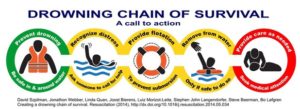
People at Higher Risk of Drowning
- Children
- Males
- People with seizure disorder or certain medical condition
Stages of Drowning
1. Surprise
- Recognizes the threat
- Position is almost vertical.
- Leg mobility is little to non-existent.
- Head tilted back with arms at or near the surface
- There are very few sounds.
- Random gasping 45 seconds to 1 minute while struggling to breathe
2. Involuntary breath holding
- sunk below the waterline
- Initiates the involuntary retention of breath.
- The mouth has been flooded.
- The epiglottis protects the airway.
- May continue to have difficulties.
- Normally, there are no sounds.
- The victim is depleted of oxygen.
- 1:30 to 1 minute
3. Unconsciousness
- Respiratory arrest occurs when breathing stops.
- Sinks to the bottom
- There is no movement in the chest.
- Continue to be unconscious for 2 to 3 minutes unless breathing is restored.
4. Hypoxic convulsion
- Lips and fingernail beds, in particular.
- The body may look to be stiff.
- Jerking violently
- frothing at the mouth
- three to four minutes
5. Clinical death
- Cardiac arrest
- The heart stops
- Organs aren’t getting enough oxygen-rich blood.
- 6 minutes later, skin becomes blue, and you’re dead.
Types of Drowning
1. Wet drowning
- Wet drowning is the result of fluid inhalation obstructing the airways and lungs.
- In autopsy, usual signs can be identified.
2. Dry drowning
- Due to the introduction of water into the nasopharynx and larynx, only a small amount of water enters the lungs, making it the best situation for resuscitation.
3. Secondary/ near drowning
- The main causes of secondary/near drowning are: infection from inhaling contaminated water, lung difficulties, a lack of oxygen, a fatigued heart muscle, and brain edema.
- Initial resuscitation may result in a person who appears alert and breathing.
4. Immersion syndrome
- It can also be caused by inexperienced swimmers falling or diving with their feet or duck diving.
- In these cases, the loss of consciousness is instantaneous, and death happens within minutes.
- The autopsy reveals no symptoms of drowning.
Preventive Measures of Drowning
- Fence the pool: Installing barriers to prevent access to water hazards (e.g., covering wells, utilizing entryway barriers and playpens, fencing swimming pools, etc.)
- Shut the gates
- Teach the kids to swim: Teach school-aged children basic swimming, water safety, and safe rescue abilities with a focus on safety and an overall risk management strategy that includes a safety-tested curriculum, a secure training location, screening and student selection, and specified student-instructor ratios.
- Effective policies: Drowning prevention also necessitates effective policies and regulations.
- Improve flood resilience: Flooding can be avoided by improving flood resilience and reducing flood hazards through better disaster preparedness planning, land use planning, and early warning systems.
- Learn how to resuscitate
- Develop water safety strategy: Creating a national water safety strategy can help raise awareness of water safety, to lead multi-sectoral action
First Aid for Drowning
First Aid involves various actions and steps. They are:
- Keep the drowned person on their back and a flat surface. Make sure to handle the person gently as they may be unconscious.
- Call the drowned person by their names and try to talk to them so that they remain alert and conscious.
- Shake their shoulders to ensure that they are responding.
- If the person does not respond, check their breathing.
- Call the Red Cross or nearest health facility for further assistance.
If the person is breathing:
- Place the person in recovery position and warm him/her with dry clothes/blankets.
- Change their wet clothes and wait for the ambulance.
If the person is not breathing:
- Elevate the head of the person by placing a hand on the forehead and another hand down the chin and lifting it gently to clear the airway.
- Check their pulse by placing two fingers on the windpipe (Adam’s apple).
- Start artificial respiration (mouth-to-mouth resuscitation) straight away by slowly blowing into the mouth of the person 5 times (for 1.5 to 2 seconds) while observing their chest as it rises with each blow.
- Wait until the chest drops back before you blow into their mouth again.
- Start cardiopulmonary resuscitation CPR (30 chest compressions). (Process to given CPR is described below)
- Repeat mouth-to-mouth resuscitation twice then do CPR once, until the person wakes up or until the ambulance arrives.
- If the person starts breathing again before the ambulance arrives, they must be warmed up with clothes or blankets and their wet clothes must be changed.
- Monitor the patient and keep checking their pulse and breathing until the ambulance arrives.
How To give CPR for An Infant, Adult or Child?
Following steps can be followed to provide CPR for an infant:
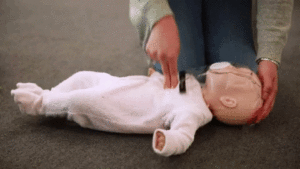
- Place the infant onto back
- Place your index and middle finger over the lower half of sternum (breastbone)
- Provide 30 compressions 1/3 of the depth of the casualties chest
- Slightly tilt the head back
- Lift chin to move the tongue away from the back of the throat
- Provide two soft puffs (not full breaths as this can damage the infant’s lungs)
- Repeat sequence until medical assistance arrives or the casualty becomes conscious
Following steps can be followed to provide CPR for an adult or child:
- Place casualty onto back
- Place one index finger on the middle of the collarbone and the other index finger on the sternum (where the ribcage meets below the chest)
- Your two thumbs will meet in between your index fingers. This marks the location where you will place your right hand. Position the base of your hand (just above your wrist joint) here
- Place your left hand on top of your right hand, clasp and push
- Provide 30 compressions 1/3 of the depth of the casualties chest
- Tilt head back, lift chin, open mouth and pinch the soft part of the nose
- Provide 2 breaths – watch and listen for the chest to rise and fall
- Repeat sequence until medical assistance arrives or the casualty becomes conscious
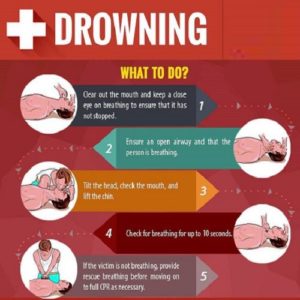
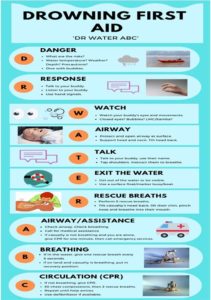
WHO Response in Drowning
- In November of 2014, the World Health Organization (WHO) published a global report on drowning. This was the first time the WHO has produced a report solely dedicated to drowning.
- The Global Report on Drowning makes recommendations to governments on how to customize and implement effective drowning prevention programs to their specific circumstances, improve drowning data, and build national water safety strategies.
- WHO published Preventing Drowning: An Implementation Guide in May 2017.
- WHO has partnered with Ministries of Health in various low- and middle-income countries to avoid drowning by using barriers to regulate access to water and establishing day care centers for pre-school children at the country level.
- WHO offers training programs and workshops at the regional level to bring together representatives from governments, NGOs, and UN organizations working on drowning prevention.
References and For More Information
https://www.who.int/news-room/fact-sheets/detail/drowning
https://www.cdc.gov/drowning/prevention/index.html
https://emedicine.medscape.com/article/772753-overview
https://www.emedicinehealth.com/drowning/article_em.htm
https://firstaidforlife.org.uk/first-aid-drowning-adult-baby-child/
https://www.sciencedirect.com/science/article/abs/pii/S0012369220348960
https://bestpractice.bmj.com/topics/en-us/657
https://www.moh.gov.sa/en/awarenessplateform/FirstAid/Pages/Drowning.aspx